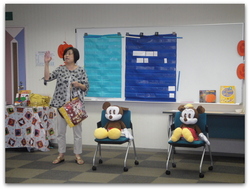 It was really great to have teachers not only from the Kansai area but also from Ishikawa, Tokushima and even from Chiba on Sep. 7th. It was a great time to study and discuss many important issues. The room was heated up with the passion the teachers have for their students. We hope you will enjoy reading about some of the things we did and get some ideas for your classes, too.
It was really great to have teachers not only from the Kansai area but also from Ishikawa, Tokushima and even from Chiba on Sep. 7th. It was a great time to study and discuss many important issues. The room was heated up with the passion the teachers have for their students. We hope you will enjoy reading about some of the things we did and get some ideas for your classes, too.
First we sang a Warm Up Song. The original song is “Whose Watch is This?” from “Let’s Chant! Let’s Sing Book 2” (p.27, Oxford University Press). We changed the lyrics to “Whose bag is this? It’s Mickey’s bag. It’s his bag”, which were the target sentences of the workshop. Since the concept of pronouns is a little difficult for Japanese learners, we suggested using this song as a review. We hope it will help your students learn the possessive pronouns in a fun way.
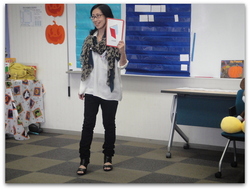 One of the points we focused on in Practice Key 1 was how to teach countable and uncountable nouns. When we teach with the MAT EMTHOD, we use ‘Actions’ for the articles “a” and “an” and hide the action behind us when we don’t say “a/an”. We know there are different opinions about whether grammatical explanation is necessary or not. Especially for younger students, under the age of 8, it seems that it is difficult for them to understand the meaning of the rules or to judge when to use the rules. So, we believe that it might be better for them to just simply use and say the language many, many times and learn that there are times that they need to say “a/an” and the times they do not need to say it. For older children, who can think logically, find the rules themselves and can apply the rules when they come across a new situation to use the language, it might be good to briefly explain what countable and uncountable means. In either case, the MAT METHOD is designed to have your students use and say the target language many times in a fun atmosphere. Thus they will be motivated to learn. As you teach with the MAT METHOD, the students will be exposed to English a lot and will be giving output with English a lot. This will help them understand the grammatical explanations later on. Also this repetition is the basis of acquiring a language.
One of the points we focused on in Practice Key 1 was how to teach countable and uncountable nouns. When we teach with the MAT EMTHOD, we use ‘Actions’ for the articles “a” and “an” and hide the action behind us when we don’t say “a/an”. We know there are different opinions about whether grammatical explanation is necessary or not. Especially for younger students, under the age of 8, it seems that it is difficult for them to understand the meaning of the rules or to judge when to use the rules. So, we believe that it might be better for them to just simply use and say the language many, many times and learn that there are times that they need to say “a/an” and the times they do not need to say it. For older children, who can think logically, find the rules themselves and can apply the rules when they come across a new situation to use the language, it might be good to briefly explain what countable and uncountable means. In either case, the MAT METHOD is designed to have your students use and say the target language many times in a fun atmosphere. Thus they will be motivated to learn. As you teach with the MAT METHOD, the students will be exposed to English a lot and will be giving output with English a lot. This will help them understand the grammatical explanations later on. Also this repetition is the basis of acquiring a language.
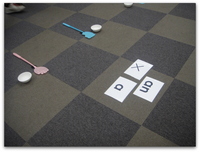 To have your students use the language more in a fun way, we use Learning Activities. The Learning Activity we introduced here was “The Flyswatter Game”. As the students finish saying a sentence, they have to swat either of the card “a”” an” or “×” correctly according to the sentence. It was fun to see the teachers getting so serious about doing a game. It made us all laugh.
To have your students use the language more in a fun way, we use Learning Activities. The Learning Activity we introduced here was “The Flyswatter Game”. As the students finish saying a sentence, they have to swat either of the card “a”” an” or “×” correctly according to the sentence. It was fun to see the teachers getting so serious about doing a game. It made us all laugh.
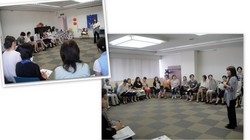
In Practice Key 2, we introduced how to teach possessive nouns and pronouns focusing on the words ‘Mickey’s, Minnie’s, his and her’. What are the steps we need to think of? Here again, it is effective to use ‘Actions’. By using different actions, students will learn that they will learn to distinguish he/his and she/her. Also it is important to check the meaning in Japanese when the language includes an abstract concept. After introducing when and how to use the target language, we need to practice a lot so that the students can use the language fluently and correctly.
As for a Learning Activity, we did a “Dice Game” where students have to make sentences as quickly as possible according to what was shown on the the dice. Also we had fun with the Activity, “Our Classmates’ Belongings Game”. When Team B asks “Whose pen is this?”, Team A has to answer, for example, “It’s Yuko’s pen. It’s her pen.” within five seconds, or the pen will be the teacher’s. The game like this will enable the students to see when and how the language can actually be used in real life. We think using real things is another point that we should try to put into every lesson we do.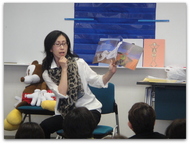
In the last part of our session we had fun listening to Halloween stories, singing Halloween songs and doing Halloween Activities. “Whose hat is this?” Although it looks like the witch’s pointed hat, surprisingly it was the skeleton’s hat! “It’s his hat!” As for prizes for the winners, spiders made of jelly were prepared. We all had a lot of fun and we hope you will have more fun with your students using these ideas. 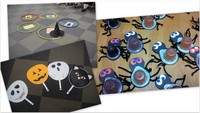
Our next Study Group Meeting will be on November 23rd.
We hope to see you then.